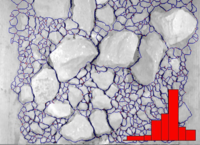Mesh (scale)

Imagine you have a piece of cloth with tiny holes in it. These holes are very close together and make a sort of grid pattern on the fabric. This is very similar to what a mesh is. A mesh is basically a net-like structure made up of tiny spaces or holes that are very close to each other.
Now, let's imagine you have two pieces of cloth with the same size and shape, but one piece has larger holes or spaces in it, while the other has smaller holes or spaces. The piece with smaller holes will have more of them in the same area compared to the piece with larger holes, right? This is similar to how mesh works.
When we talk about mesh scale, we're talking about how small or large the holes or spaces in the mesh are. The smaller the mesh scale, the more holes or spaces there will be per unit of area. This is important in many different applications, such as filtering liquids, creating 3D models, or even designing clothing or decorative items.
For example, imagine you want to use mesh to filter water. If you use a mesh with a large scale, some of the impurities in the water may still slip through the large holes. But if you use a mesh with a small scale, there will be more holes to catch those impurities, so the water that comes out will be cleaner.
In conclusion, mesh is a net-like structure made up of tiny spaces or holes. Mesh scale refers to how small or large those spaces are, and it's important in many different applications where we need to filter or create different patterns or shapes.
Now, let's imagine you have two pieces of cloth with the same size and shape, but one piece has larger holes or spaces in it, while the other has smaller holes or spaces. The piece with smaller holes will have more of them in the same area compared to the piece with larger holes, right? This is similar to how mesh works.
When we talk about mesh scale, we're talking about how small or large the holes or spaces in the mesh are. The smaller the mesh scale, the more holes or spaces there will be per unit of area. This is important in many different applications, such as filtering liquids, creating 3D models, or even designing clothing or decorative items.
For example, imagine you want to use mesh to filter water. If you use a mesh with a large scale, some of the impurities in the water may still slip through the large holes. But if you use a mesh with a small scale, there will be more holes to catch those impurities, so the water that comes out will be cleaner.
In conclusion, mesh is a net-like structure made up of tiny spaces or holes. Mesh scale refers to how small or large those spaces are, and it's important in many different applications where we need to filter or create different patterns or shapes.
